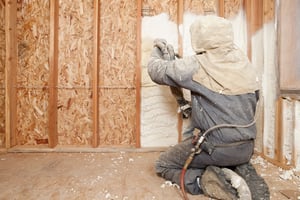 Increased emphasis on green building design has resulted in a greater demand for more energy efficient building materials such as spray polyurethane foam (SPF) insulations. Despite their excellent air sealing capability and insulating properties, the U.S. Environmental Protection Agency has recognized that exposure to the isocyanates and other vapors, aerosols, and dusts created during and after installation, may cause respiratory sensitization, asthma, and odors.
Increased emphasis on green building design has resulted in a greater demand for more energy efficient building materials such as spray polyurethane foam (SPF) insulations. Despite their excellent air sealing capability and insulating properties, the U.S. Environmental Protection Agency has recognized that exposure to the isocyanates and other vapors, aerosols, and dusts created during and after installation, may cause respiratory sensitization, asthma, and odors.
CCA has the qualifications and investigative expertise to assess the proper installation of SPF insulation and conduct indoor air quality (IAQ) testing for SPF-specific chemicals. It is also important to note that other sources of indoor pollutants (besides SPF insulation) may be responsible for an occupant’s symptoms. CCA will take an unbiased approach to investigate and characterize a building’s indoor air quality, to ensure the proper identification and mitigation of all potential sources of contamination. Although each IAQ issue is unique, examples of our IAQ testing methods include:
- IAQ Performance Measurements. Direct-reading measurements of building temperature, relative humidity, carbon monoxide, and carbon dioxide.
- Volatile Organic Compound (VOCs) Measurements. Initial screening measurements for total VOCs.
- Time-integrated Air Sampling. Techniques may include laboratory analysis to identify specific VOCs or aerosols including: formaldehyde, ozone, combustion products, heavy metals.
- Whole Air Sampling. Sampling using an evacuated canister for analysis using EPA methods TO-14A and TO-15 to assess a broad-range of hazardous air pollutants.
- Airborne Mold Sampling. Culture-based and non-culture-based air sampling to measure the pretense and concentration of airborne fungi.
Dr. Michael P. Mellette is a Certified Industrial Hygienist (CIH) and has conducted a variety of research studies related to the chemical sensitizers found in spray polyurethane foams and other chemicals used in the construction industry. Contact CCA today for help assessing your SPF insulation related indoor air quality problems or for insurance claim and expert litigation support.
Recent Papers:
Mellette, Michael P., Dhimiter Bello, Yalong Xue, Michael Yost, Anila Bello, and Susan Woskie. 2018. "Testing of Disposable Protective Garments Against Isocyanate Permeation From Spray Polyurethane Foam Insulation." Annals of Work Exposures and Health 62(6):754–64.
Mellette, Michael P., Dhimiter Bello, Yalong Xue, Michael Yost, Anila Bello, and Susan Woskie. 2019. "Evaluation of Disposable Protective Garments against Isocyanate Permeation and Penetration from Polyurethane Anticorrosion Coatings." Annals of Work Exposures and Health 63(5):592–603.
References
U.S. EPA. n.d. "Health Concerns about Spray Polyurethane Foam.” Washington, DC: U.S. Environmental Protection Agency."
U.S. ATSDR. 2015. "Public Health Statement for Toluene Diisocyanate and Methylenediphenyl Diisocyanate." Atlanta, GA: Agency for Toxic Substances and Disease Registry.


